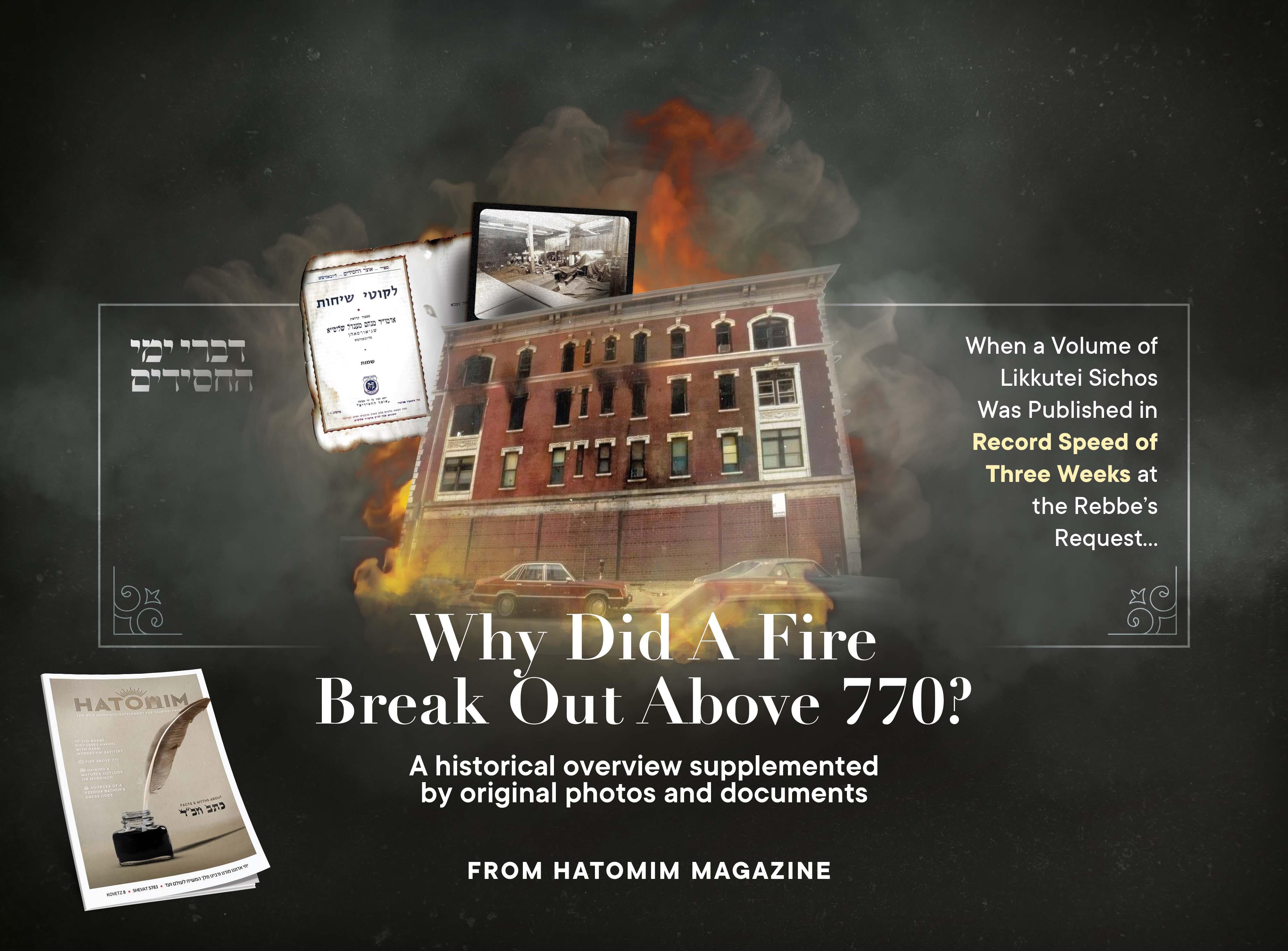Why Did A Fire Break Out Above 770?
Why Did A Fire Break Out Above 770? A historical overview supplemented by original photos and documents • From Hatomim Magazine • Full Article
From the new Hatomim Magazine for Yud Shvat 5783, Download it here for free
On Thursday, 21 Teves 5743, Rabbi Zalman Shimon Dworkin, the rav of Crown Heights, received $12,000 from the Rebbe along with the following letter:
BH. You surely heard of the fire ל”ע ול”ע that took place this morning. The waters etc. have reached and damaged the shul, and only by miracle did it not affect the Sifrei Torah etc.
Even though this shouldn’t be spoken about and obviously shouldn’t be publicized (so not to instill fear etc.), still, for the good of the shul (as I have written long ago, but nothing concrete has been done about it וד”ל) -– herewith is attached a sum of money in its value received in exchange for it from someone who isn’t a resident of this neighborhood, who obviously has no influence neither in the committee of the mikvah, nor in that of neighborhood, or with the rabbonim of the neighborhood.
The sum is $10,000 (according to what I wrote then), plus $1000 for the shul and $1000 he donated for the mikvah.
The buyer will not make anything about this public (to protect the honor of Lubavitch and my honor) and won’t interfere in the administration of the shul at all.
However, there’s no permission to make the building smaller or to expand it, and neither to apply nay significant changes to it – and anything of the like – against his will.
May Hashem fence in all the breaches of His nation in both communal and personal matters, and may the famous saying of the holy Sages be fulfilled [that after a fire one becomes wealthy]. And may you rebuild in the very same place as per the instructions (that come with a gift of power) that appear in the holy letters of the Alter Rebbe and the Tzemach Tzedek.
May thre only visible and revealed good be here and in all places where Jewish people שליט”א reside.
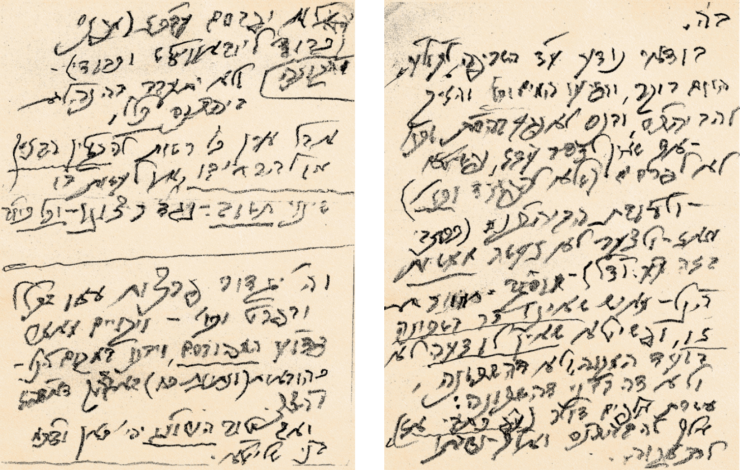


What was this letter all about? Which fire was the Rebbe talking about? And why was the Rebbe selling 770 and sending the money to the Crown Heights rav?
***
It all began on a wintry Friday in Kislev of 5743 (1982), Erev Shabbos Parshas Toldos. The latest volume of Likkutei Sichos – Volume 19 on Sefer Devarim – had just been published, and the members of the Vaad L’hafotzas Sichos had submitted a copy for the Rebbe’s approval. A few hours later they received the Rebbe’s answer:
On top of the page, the Rebbe had written his usual acknowledgment and thank you, but at the bottom of the margin was an unexpected surprise (see facsimile #1). There the Rebbe had written: “It is imperative that the section on Bereishis be published in time for the corresponding weeks of 5743, and the sooner the better. Surely you will have good news to report about this.”



The members of the Vaad were stunned. They looked at the Rebbe’s response and wondered how they would ever be able to fulfill the Rebbe’s directive. Only six weeks remained until the end of Bereishis, and from past experience they knew that under usual circumstances, it would be impossible to finish a book in such a short time. Even today, in the age of the computer, publishing a book of hundreds of pages in a few weeks is an extraordinary undertaking. But in those days it wasn’t just difficult, it was beyond the realm of possibility. Plus, it would not be the only project the Vaad would be working on. It was still in charge of the weekly Likkut, which took dozens of hours to prepare.
In addition to the technical difficulties, the Vaad faced another problem. In accordance with one of the Rebbe’s previous directives to include as many sichos as possible, the last few volumes of Likkutei Sichos had contained five sichos on every parsha. These were taken from the weekly Likkut that had been published during the last five years, between 5735 and 5740. If the next volume of Sefer Bereishis would be published at this point, it would contain only two sichos on each parsha.
The members of the Vaad decided to write to the Rebbe for further instructions, and asked if they might postpone the new volume until the Rebbe had edited the sichos through Parshas Vayechi. That would allow them to include three sichos for every parsha. They also wrote that if they printed the book with only two, the resulting volume would have only half as many pages as the previous ones, approximately 300 instead of 600. The Vaad listed which particular sichos were ready, which had been typed and needed editing, and which ones they had not yet begun to prepare. They also listed the topics to be included in the addendum.
According to the plan, the addendum to Volume 20 would be a major part of the book, containing many of the Rebbe’s letters relating to the various sichos. When the Rebbe edited the introduction to Volume 15, he had appealed to everyone who had such letters to give them to the Vaad for publication, citing “the merit of the many.”



The Rebbe’s answer wasn’t long in coming (see facsimile #2). As far as postponing the project was concerned, the Rebbe wrote that they should “Submit it to me no later than Erev Shabbos Kodesh Vayigash or even earlier if necessary.” Concerning the list of topics submitted for the addendum, the Rebbe wrote: “You may use these, and also include the sichos for chasan and kalla and bar mitzva [which the Rebbe said at the group yechidus after Yud-Tes Kislev], and letters about Chanuka. At least 100 copies [of the sefarim] should be bound and printed before Shabbos Parshas Vayechi.”
***
The Vaad L’hafotzas Sichos embarked on the new project at a frenzied pace, working day and night to fulfill the Rebbe’s wishes. During those few weeks, the members of the Vaad barely saw their families. From Motzoei Shabbos to Friday afternoon they remained in their editorial offices, emerging only to daven, go to the mikva, or to catch a few hours of much needed sleep. Food was provided by their nashim tzidkaniyos, who brought it to their husbands at 788 Eastern Parkway.
But the members of the Vaad were only human beings, and at a certain point they despaired of ever completing the task in time. In response to another letter they submitted, the Rebbe indicated that they should not wait for the sichos on Parshas Vayechi or even Vayigash (see facsimile #3). However, it was still of the utmost importance that the book be published before Bereishis was completed.



[Incidentally, at this point the Rebbe gave his approval for the Vaad to include in the addendum the sichos and maamarim that had been said from the Rebbe’s room during his convalescence from his heart attack in 5738. These sichos, said on Motzoei Shabbos, had been broadcast to the Beis Medrash downstairs in 770, and later edited by the Rebbe. The Vaad had previously requested to print them as a separate volume, but the Rebbe had negated the idea. The Vaad saw the Rebbe’s permission to include them in Volume 20 as an indication that he considered them an integral part of his usual sichos and maamarim, no different from those that were said at Shabbos farbrengens.]
The work progressed in a miraculous manner. When the Vaad submitted the galleys on Parshas Vayigash, the Rebbe responded (see facsimile #4): “Fast! And if you hurry up with Parshas Vayechi, everything can be included in the volume.”
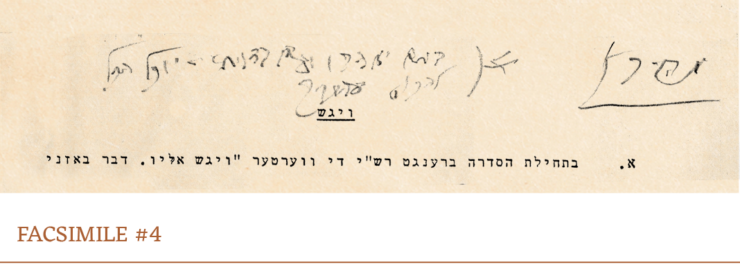


The members of the Vaad worked faster, pushing themselves beyond human endurance. A short time later, even Vayechi was ready for the Rebbe’s approval. Returned only a few hours after it was submitted, the galleys were immediately sent off to the printing presses, with instructions that all other work be interrupted. Every piece of machinery was to be used only for publishing the new volume – 100 copies before Shabbos Vayigash.
The manager of the printing press, who was not a Chabad Chassid, considered it a great merit to print the Rebbe’s works, and stayed up the entire night to supervise. Interestingly, when his wife brought him some sandwiches in the middle of the night, he refused to eat them, saying that he didn’t think it was right to eat something that wasn’t completely kosher while he was working on the Rebbe’s books! His wife went back to Manhattan, where she found a kosher restaurant and bought him supper. But her husband wouldn’t eat it until he saw the words “Glatt kosher” on the wrapping…
***
By the next morning, the unbelievable had happened. The 20th volume of Likkutei Sichos was in print – before Shabbos Parshas Vayigash!
The public was astounded by the speed at which the Rebbe’s works were being published. Even the pages of Volume 20 were of the finest quality, and the binding was particularly impressive. But the most important thing was that the book contained the sichos on Parshas Vayechi – the first time a volume of Likkutei Sichos contained a weekly Likkut that had not yet been printed as an individual Likkut!
Why had it been so important to the Rebbe for the project to be finished before the end of Bereishis? It was the only question on everyone’s mind throughout the weeks of frantic activity.
In the past, the Rebbe had sometimes indicated that a book be printed before a certain date, but never with the same sense of urgency. Usually these were books about the Chabad Rebbeim, whose publication the Rebbe wanted to coincide with their yahrtzeit or another significant day.
In fact, the Rebbe’s insistence in this case was unprecedented for two reasons: 1) the Rebbe had never before rushed the publication of any of his works, and 2) the date of completion was not known to be particularly significant. But the Rebbe had repeatedly stated that he wanted these sichos to be learned at the same time the parsha was being read in shul. The members of the Vaad realized that there must be a spiritual reason behind the deadline, but it was simply beyond their capacity to understand it.
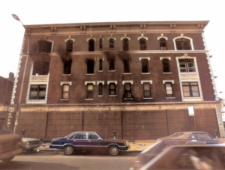


Front view of 788 Eastern Parkway the day after the fire.
***
On Wednesday night of the week of Parshas Shemos, a fire broke out in the printing room of the Vaad, on the third floor of 788 Eastern Parkway. A passerby noticed the flames sometime after midnight, and dozens of fire trucks responded to the alarm. Huge quantities of water were sprayed into the building, but the fire wasn’t brought under control until every single printing press of the Vaad L’hafotzas Sichos had been reduced to ash.
Even before the smoke dissipated, the members of the Vaad ran to see what they could salvage, and breathed a collective sigh of relief when they saw that the fire had stopped directly in front of their offices. The hundreds of volumes of the new Likkutei Sichos had been spared, together with their priceless archives.
But the biggest surprise was waiting in the middle of the printing room. On one press that had actually started to melt from the heat were thousands of copies of the weekly Likkut – virtually untouched by the flames! Only the margins of the pages had been slightly charred (see photo). The Rebbe’s holy sichos had withstood the test of fire.
The next morning, the members of the Vaad, Rabbis Shalom Jacobson, Shneur Zalman Chanin, Nachman Schapiro, and Leibel Altein, informed the Rebbe about the incident and asked for a bracha to recover from the damage. The Rebbe responded (see facsimile #5): “May it be G-d’s will that the famous saying of our holy Sages be fulfilled [that after a fire one becomes wealthy]. May you have revealed good to report, and particular success in disseminating the wellsprings outward. I will mention it at the tziyun affirmatively.”



A few days before the fire, a small blaze had broken out under the bima in 770, in the exact place where the Rebbe sat at farbrengens. A few bachurim extinguished it before it could spread, G-d forbid. No one could figure out how it had started, and it remained a mystery.
But at the farbrengen of Shabbos Parshas Shemos, the Rebbe explained what was really going on…
***
A few years before, in 5740, a group of community activists had begun building a new mikva for the women of Crown Heights. Unfortunately, in their eagerness to complete the project, one of the directors on the board decided to raze the old building even before the new one was completed. Due to this hasty and premature step, a fully renovated mikva would not be available for another two years, the time it took to complete the new mikva. In the meantime, the women who used the mikva had to navigate an open construction site, and several were badly injured in accidents.
On Erev Shabbos Kodesh 12 MarCheshvan 5743, the Rebbe wrote a sharply worded letter to the people in charge of the project:
“…The event that took place was frightful, and it is even more appalling that no one is paying attention to this at all! The only women’s mikva in the neighborhood of Lubavitch, visited by Chabad women from around the world, was destroyed two years ago with public money and in [inappropriate] haste.
“As they are apparently ‘unaware’ of what happened, I would like to inform them: 1) There is still no mikva here; 2) according to the Shulchan Aruch regarding a synagogue, even when other synagogues exist, it requires serious investigation as to how it can be destroyed in the first place; 3) In a case where it is permissible to destroy one (which was not at all the case here), ‘the new one must be built very quickly, working night and day,’ according to the Shulchan Aruch.
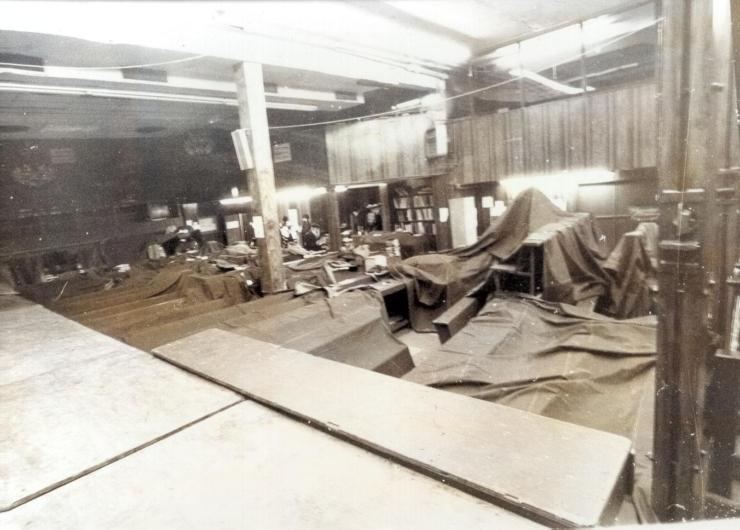


Downstairs zal of 770 as the firemen combat the blaze upstairs. The benches are covered with plastic sheeting to prevent water damage
“With my own eyes I have seen how days go by without any work being done by day or by night. May G-d have mercy on us all, together with the rest of Klal Yisrael. May this be concluded in a good manner.”
On Erev Shabbos Kodesh Parshas Vayechi the Rebbe wrote an even sharper letter:
“The ruling that it is permissible and laudable to sell a synagogue for the purpose of building a mikva is well known. I was promised that the mikva would be completed by mid-summer, then informed that it would take until Rosh Hashana, then Succos, then another two or three weeks.
“On 14 Teves I visited the building. It will not be completed within two or three weeks.
“If you are really concerned about the wellbeing of the Beis Medrash, let it be sold, and the money given to someone who is not a Lubavitcher. Give him $10,000 as compensation for his work – just make sure that the mikva is completed within three weeks. And no one from Lubavitch should offer him advice.”
***
In the middle of the farbrengen of Shabbos Kodesh Parshas Shemos the Rebbe suddenly brought up the topic of the unfinished mikva.
“There is a certain matter,” the Rebbe said, “that I have mentioned at least a hundred and one times. For three years I’ve been talking about building the mikva, and despite all the meetings that have been convened and a great deal of discussion, it is not yet finished.
“Of all the times I visited the mikva, not once did I see someone in charge actually on site! I have visited many, many times, at different times of day – early, late, and at the beginning of the day (at least at the beginning of my day, which is still before noon) – and only on one occasion did I encounter someone in charge. And this was only within the past two weeks: the individual must have appeared only to ensure that I wouldn’t mention it at a farbrengen.
“But I have mentioned it at farbrengens, and the contents of farbrengens are written down, and people are aware of what must be done. Yet no one thinks that my words are directed to him – only to the next person…
“After all this was to no avail, a dreadful incident occurred to one woman, and even this seems to have had no effect!
“Then another incident occurred to a second woman, and this was also ignored, as was a third incident involving another woman!
“Then a small fire broke out very suddenly. No one knew how it started, and there is no natural explanation for it. But even this did not have any effect.
“Then a big fire broke out, may G-d protect us, and the whole neighborhood is talking about it. This blaze was also miraculous in origin: there is no natural explanation of how it started. But this too is insufficient to make an impression.
“I see that I have no other option. The building must be saved, and I have sold it…”
The Rebbe continued: “They do me a favor and record my words in print, and describe it as [the menora’s] ‘knobs and flowers,’ but when it comes to actually doing something, my words have no effect. What good are all these words if they do not result in actual deed? People talk, they ask each other questions, they offer explanations – but nothing is brought down to the level of ‘below ten handbreadths.’”
Needless to say, the public was shocked beyond words by the Rebbe’s comments.
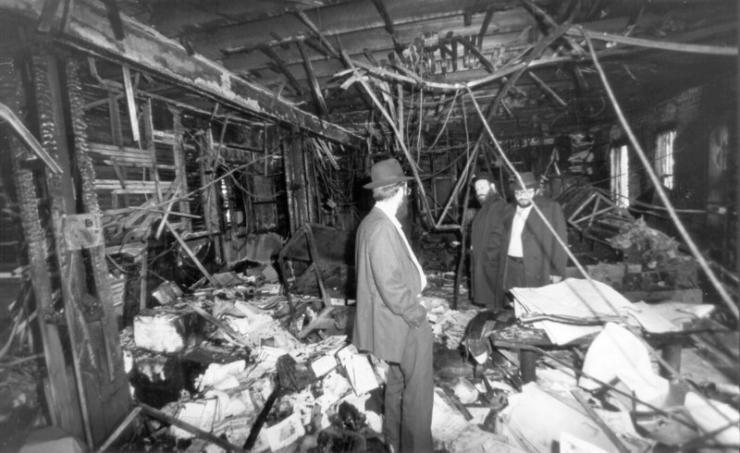


Rabbis Shalom Jacobson, Zalman Chanin and Moshe Shagalow estimate the damage after the blaze
That Friday, the sale of the Beis Medrash of 770 was conducted in absolute secrecy. That morning, the Rebbe issued a full-page directive to his secretariat that the sale be concluded that very day. Many of the details have never come out publicly.
The Rebbe instructed that the legal transfer be conducted by Rabbi Zalman Shimon Dworkin, the late rav of Lubavitch. The transaction was completed so quickly that when the buyer claimed that there was no time to assemble cash, the Rebbe instructed his secretariat to provide him with it!
The buyer, as per the Rebbe’s instructions, was not a member of Anash, and the Rebbe told the gabbaim that any proposed change in the building would henceforth have to receive the new owner’s permission. As the new owner’s identity was a secret, the Rebbe said this meant that no changes could be made.
472
Join ChabadInfo's News Roundup and alerts for the HOTTEST Chabad news and updates!










